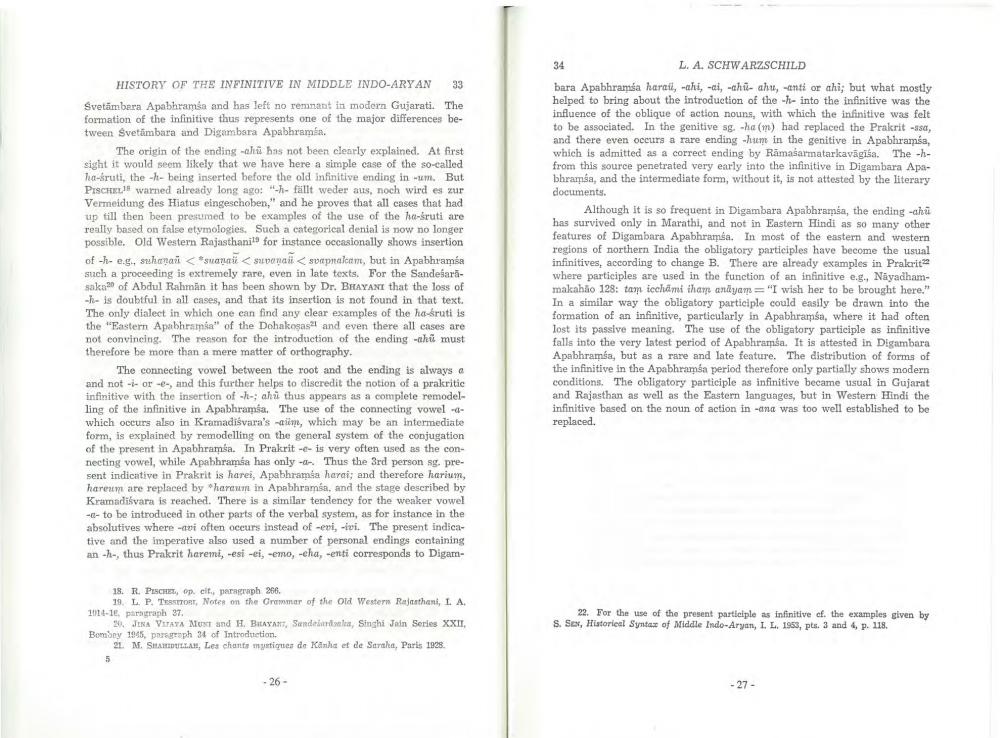________________
HISTORY OF THE INFINITIVE IN MIDDLE INDO-ARY AN 33 Svetambara Apabhramsa and has left no remnant in modern Gujarati. The formation of the infinitive thus represents one of the major differences between Svetambara and Digambara Apabhramia.
The origin of the ending -ahu has not been clearly explained. At first sight it would seem likely that we have here a simple case of the so-called ha-kruti, the -h- being inserted before the old infinitive ending in -um. But PISCHEL warned already long ago: "-h- fällt weder aus, noch wird es zur Vermeidung des Hiatus eingeschoben," and he proves that all cases that had up till then been presumed to be examples of the use of the ha-sruti are really based on false etymologies. Such a categorical denial is now no longer possible. Old Western Rajasthani for instance occasionally shows insertion of -h- e.g., suhaṇau<*suanau<suvona svapnakam, but in Apabhramsa such a proceeding is extremely rare, even in late texts. For the Sandeśarăsaka20 of Abdul Rahman it has been shown by Dr. BHAYANI that the loss of -h- is doubtful in all cases, and that its insertion is not found in that text. The only dialect in which one can find any clear examples of the ha-śruti is the "Eastern Apabhramsa" of the Dohakosas" and even there all cases are not convincing. The reason for the introduction of the ending -ahu must therefore be more than a mere matter of orthography.
The connecting vowel between the root and the ending is always a and not -i- or -e-, and this further helps to discredit the notion of a prakritic infinitive with the insertion of -h-; ahù thus appears as a complete remodelling of the infinitive in Apabhramsa. The use of the connecting vowel -awhich occurs also in Kramadiśvara's aim, which may be an intermediate form, is explained by remodelling on the general system of the conjugation of the present in Apabhramsa. In Prakrit -e- is very often used as the connecting vowel, while Apabhramsa has only -a-. Thus the 3rd person sg. present indicative in Prakrit is harei, Apabhramia harai; and therefore harium, hareum are replaced by hareum in Apabhramsa, and the stage described by Kramadisvara is reached. There is a similar tendency for the weaker vowel -- to be introduced in other parts of the verbal system, as for instance in the absolutives where -avi often occurs instead of -evi, -ivi. The present indicative and the imperative also used a number of personal endings containing an -h-, thus Prakrit haremi, -esi -ei, -emo, -eha, -enti corresponds to Digam
18. R. PISCHEL, op. cit., paragraph 266.
19. L. P. TESSITORI, Notes on the Grammar of the Old Western Rajasthani, L. A. 1014-16, paragraph 37.
2. JINA VITATA MUST and H. BRAYANT, Sandelardoala, Singhi Jain Series XXII, Bombay 1945, paragraph 34 of Introduction.
21. M. SHAHIDULLAH, Les chants mystiques de Kanha et de Saraha, Paris 1928.
5
-26
34
L. A. SCHWARZSCHILD
bara Apabhramsa harai, -ahi, -ai, -ahu- ahu, anti or ahi; but what mostly helped to bring about the introduction of the -h- into the infinitive was the influence of the oblique of action nouns, with which the infinitive was felt to be associated. In the genitive sg. -ha (m) had replaced the Prakrit -asa, and there even occurs a rare ending -hum in the genitive in Apabhramsa, which is admitted as a correct ending by Ramasarmatarkavāgīša. The -hfrom this source penetrated very early into the infinitive in Digambara Apabhramsa, and the intermediate form, without it, is not attested by the literary documents.
Although it is so frequent in Digambara Apabhramsa, the ending -ahu has survived only in Marathi, and not in Eastern Hindi as so many other features of Digambara Apabhramsa. In most of the eastern and western regions of northern India the obligatory participles have become the usual infinitives, according to change B. There are already examples in Prakrit where participles are used in the function of an infinitive e.g., Nayadhammakahão 128: tam icchami iham anayam "I wish her to be brought here." In a similar way the obligatory participle could easily be drawn into the formation of an infinitive, particularly in Apabhramsa, where it had often lost its passive meaning. The use of the obligatory participle as infinitive falls into the very latest period of Apabhramsa. It is attested in Digambara Apabhramsa, but as a rare and late feature. The distribution of forms of the infinitive in the Apabhramsa period therefore only partially shows modern conditions. The obligatory participle as infinitive became usual in Gujarat and Rajasthan as well as the Eastern languages, but in Western Hindi the infinitive based on the noun of action in -ana was too well established to be replaced.
22. For the use of the present participle as infinitive ef. the examples given by S. Sex, Historical Syntax of Middle Indo-Aryan, I. L. 1953, pts. 3 and 4, p. 118.
-27




